Introduction
This router was one of the first retested with our new wireless test process. So the retest, using 3.0.0.4.354 firmware, was done using 5 dB steps vs. the 3 dB we subsequently changed to.
Since the AC66U is the top-ranked AC1750 class router, it is frequently compared to other products. And it has always bugged me that the comparison plots like the one below didn’t provide equivalent detail for the ASUS’ performance.
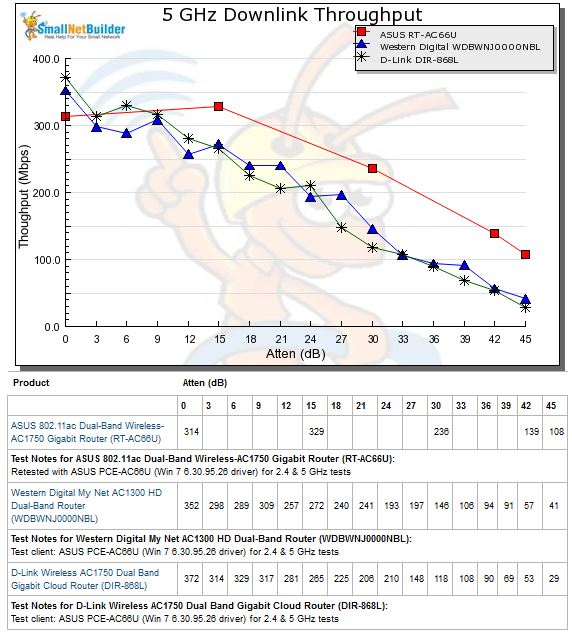
Typical ASUS RT-AC66U performance comparison
I also wondered whether the first test results were a fluke because the AC66U so consistently outperformed all other AC1750 routers. So awhile ago, I reran the test using 3.0.0.4.354 firmware, but using 3dB steps that are now our standard. Other things got in the way, however, and I did not post the new results in the Router Charts.
Note that since I had determined in the first test that the "0 degree" position in the test chamber (with the rear of the router closest to the test chamber antennas) provided best performance, I ran both retests in that position only.
When NETGEAR briefed me on its suit against ASUS, they noted that ASUS had posted new firmware for the two routers named in the suit (the RT-AC66U and RT-N65U) after NETGEAR had notified ASUS of its intent to sue.
NETGEAR said their tests showed the new firmware reduced transmit power levels. So I decided to retest the AC66U once more, this time with the latest 3.0.0.4.372_1300-gd292488 version (screenshot below).
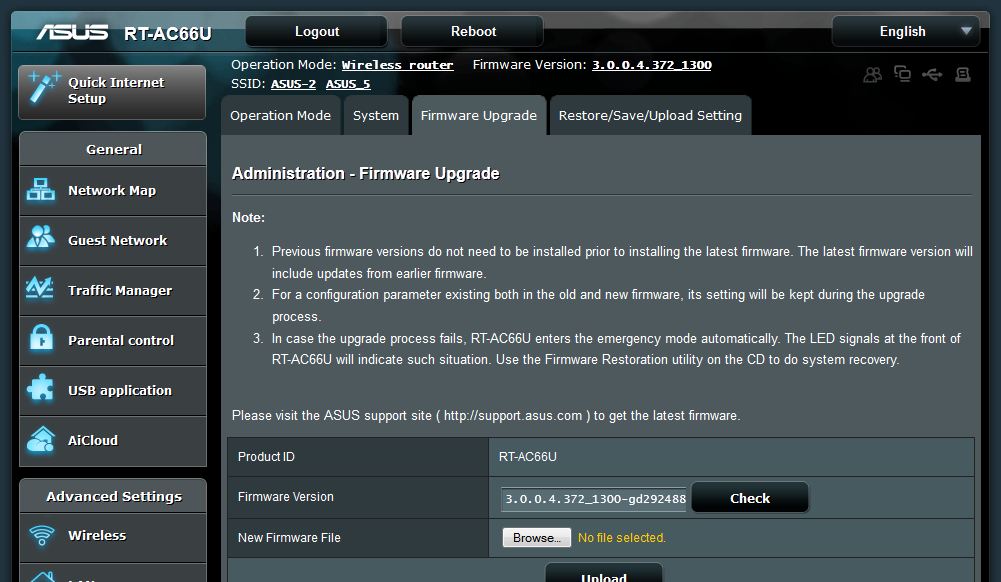
Typical ASUS RT-AC66U performance comparison
Benchmark Summary
The benchmark summary for the second retest compared to the original below it, shows slight reductions in average throughput for both 2.4 and 5 GHz unidirectional tests.
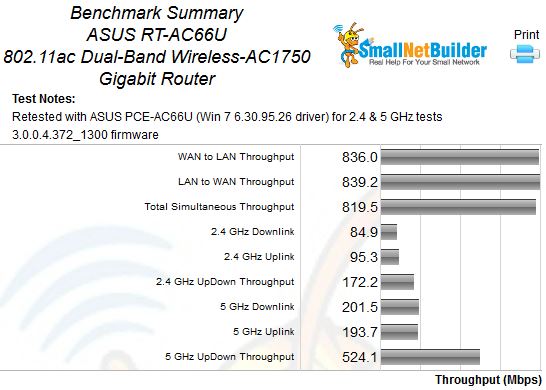
ASUS RT-AC66U Second Retest Benchmark Summary
However, simultaneous up/down throughput on both bands increased, from 165 to 172 Mbps in 2.4 GHz and 484 to 524 Mbps in 5 GHz.
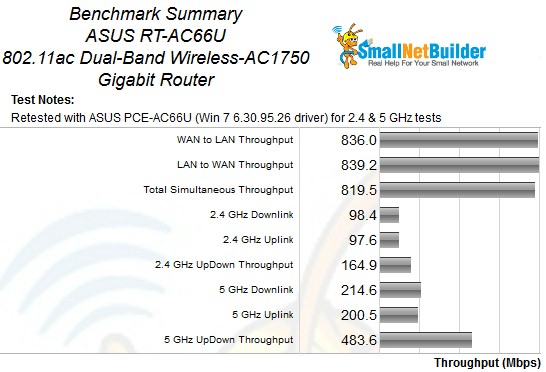
ASUS RT-AC66U First Retest Benchmark Summary
2.4 GHz Throughput vs. Attenuation
Looking at the throughput vs. attenuation plots more clearly shows the differences, as well as similarities. In the 2.4 GHz downlink plot below, all three test runs show an initial throughput dip with attenuation in the teens. The plots converge with attenuation from 20 to 30 dB, then clearly diverge starting at around 33 dB of attenuation. The three test runs then maintain their relative positions all the way down to the maximum 63 dB of attenuation the test gear can provide. The initial 5 dB step 3.354 run comes in highest, the 3 dB step 3.354 retest in the middle and the new 4.372 firmware the lowest.
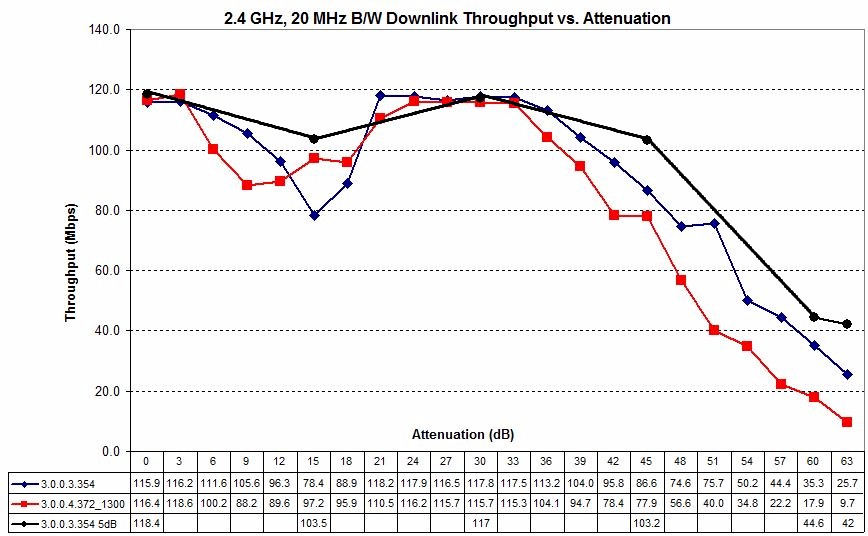
ASUS RT-AC66U 2.4 GHz Downlink Throughput vs. Attenuation
Differences in 2.4 GHz uplink performance are much harder to parse. In fact, I can’t really say that there is any significant difference
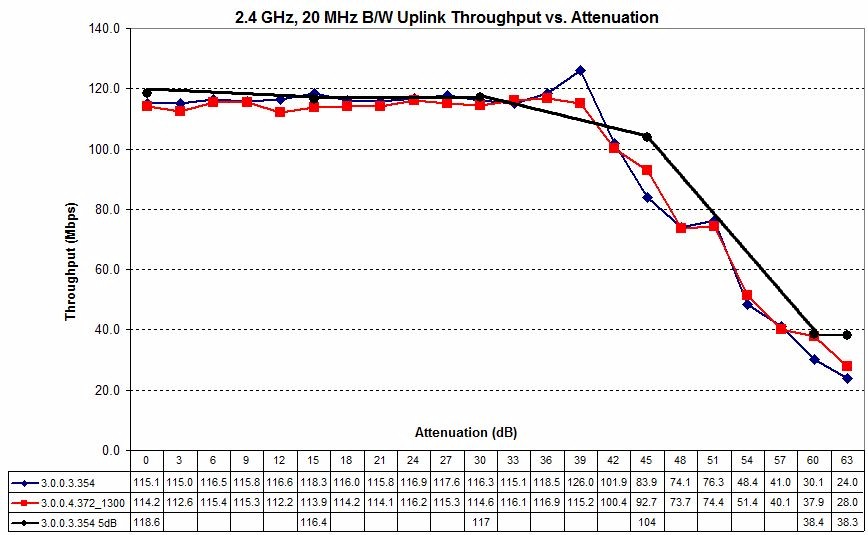
ASUS RT-AC66U 2.4 GHz Uplink Throughput vs. Attenuation
5 GHz Throughput vs. Attenuation
5 GHz downlink again shows the 4.372 firmware falling off faster after 21 dB than the two 3.354 runs.
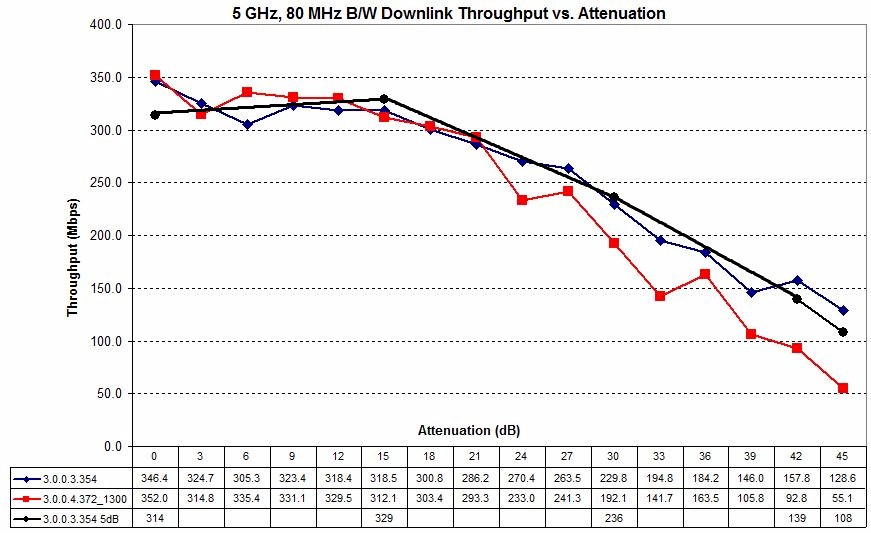
ASUS RT-AC66U 5 GHz Downlink Throughput vs. Attenuation
The 5 GHz uplink plot appears to also show lower throughput from the 4.372 firmware as signal levels fall.
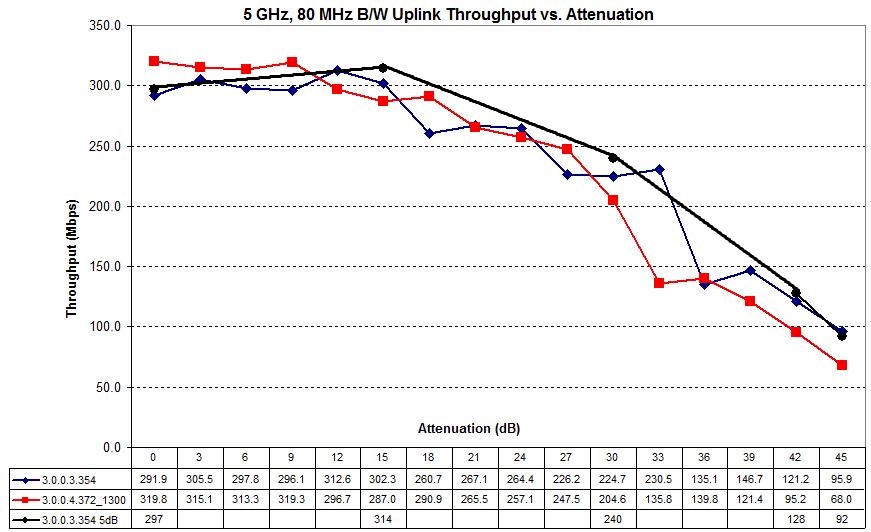
ASUS RT-AC66U 5 GHz Uplink Throughput vs. Attenuation
Competitive Comparison
So, does all this make the RT-AC66U a less attractive buy? The Router Ranker now shows the ASUS in the #2 spot behind D-Link’s DIR-868L among AC1750 class routers. But looking at the Ranker performance detail comparison below shows very close total rank scores (1.7 and 2.0) and higher wireless range ranking for the ASUS.
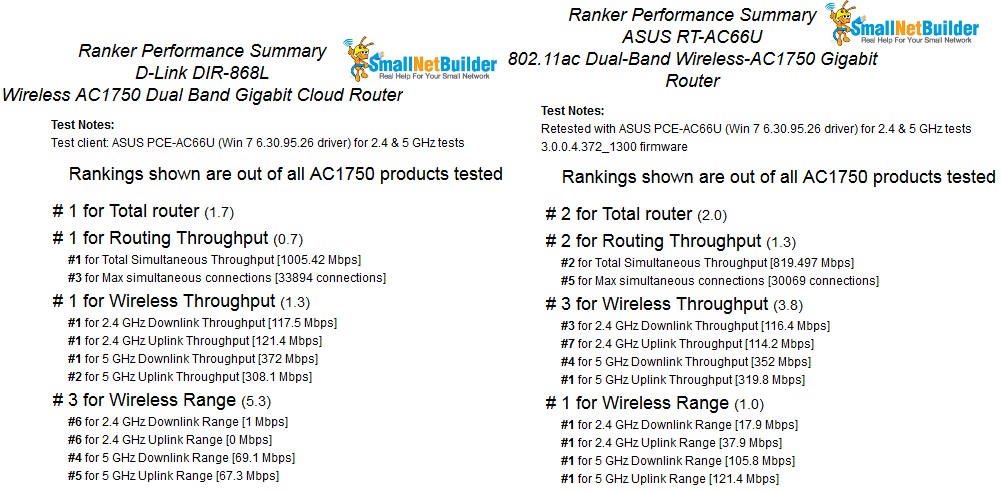
ASUS RT-AC66U & D-Link DIR-868L Ranker Performance Summary Comparison
Looking at the throughput vs. attenuation (profile) plots is also instructive. So I plotted the current top four ranked AC1750 routers for comparison, i.e. the D-Link DIR-868L (#1), ASUS RT-AC66U (#2), WD My Net AC1300 (#3) and NETGEAR R6300 (#4). ![]()
2.4 GHz downlink is pretty much a horse race, except for the ASUS’ initial throughput dip with strong signals.
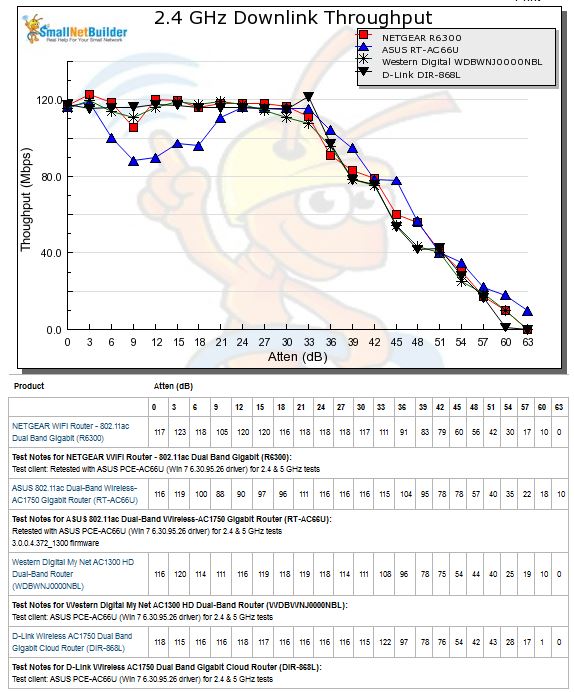
Four Top AC1750 Routers Compared – 2 4 GHz downlink
2.4 GHz uplink shows all routers evenly matched until the NETGEAR, WD and D-Link start to fall off, while the ASUS maintains higher throughput awhile longer. This indicates that the ASUS should have wider 2.4 GHz uplink coverage than the other products. But without matching downlink coverage, this uplink advantage is of questionable value.
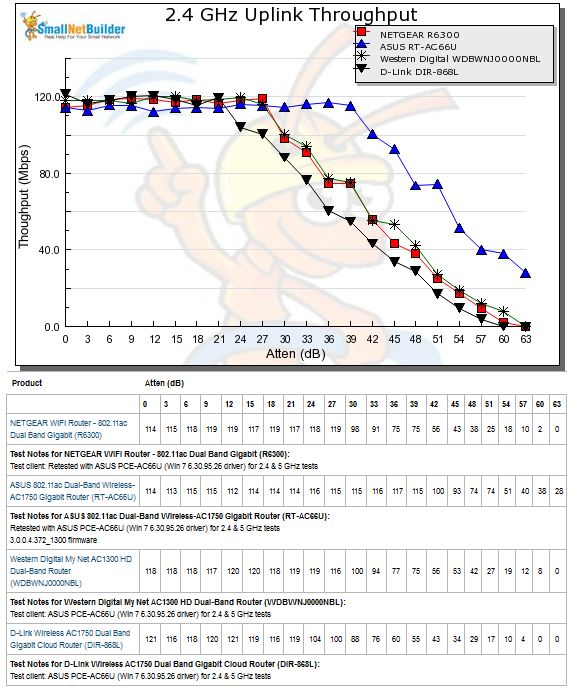
Four Top AC1750 Routers Compared – 2.4 GHz uplink
5 GHz downlink shows the ASUS tracking above the other three products from 9 dB of attenuation on. However, performance is close enough to the other products except for the NETGEAR that you might not notice the difference in real world use.
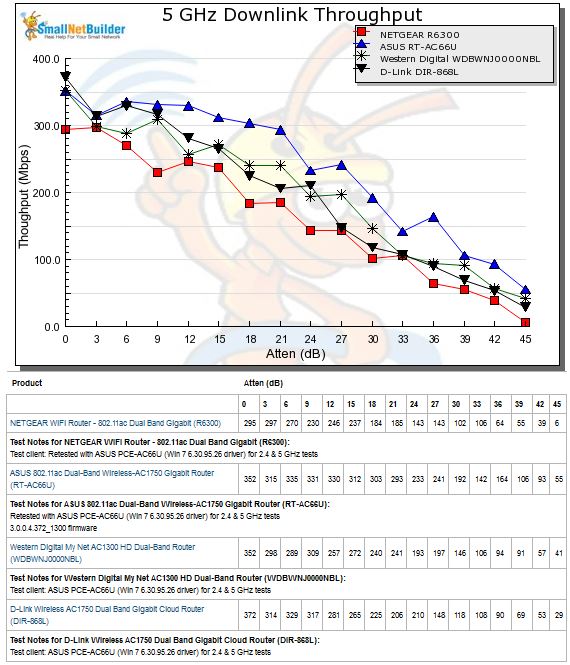
Four Top AC1750 Routers Compared – 5 GHz downlink
The story for 5 GHz uplink is similar to downlink—the ASUS should have the best coverage of this group while the NETGEAR would have the worst.
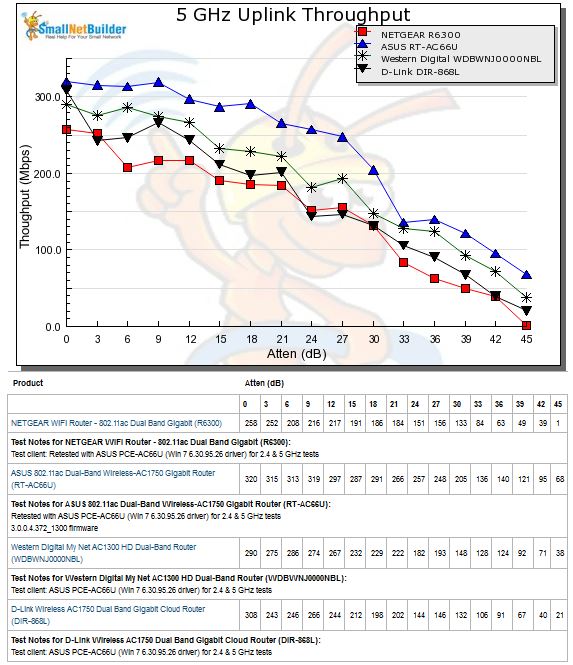
Four Top AC1750 Routers Compared – 5 GHz uplink
Closing Thoughts
It appears that NETGEAR is correct that the new firmware posted for the RT-AC66U produces lower throughput. This effect is most significant running downlink and at lower signal levels. Throughput with strong signals, doesn’t appear to be affected.
I have no way of knowing whether the tweaks ASUS made in this latest firmware bring it into FCC compliance. But even with slightly reduced performance, the RT-AC66U is still a top AC1750 class router.
